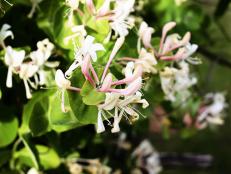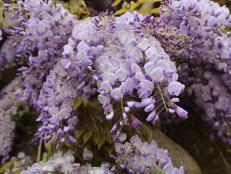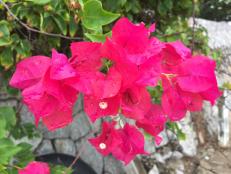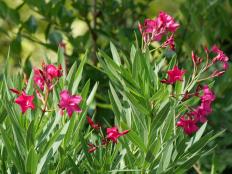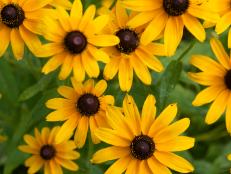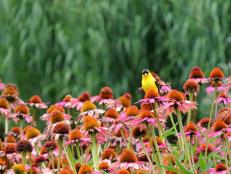Black-Eyed Susan Vine

Take your garden to new heights with black-eyed Susan vines (Thunbergia alata). This pretty climber earns its name because the flowers boast coloring similar to the classic black-eyed Susan, with golden petals surrounding a dark eye. But that’s where the resemblance ends, because black-eyed Susan vine flowers have five petals and an almost starry shape.
Black-eyed Susan vine is an easy-to-grow annual that yields months of color from inexpensive seeds. It’s a natural choice for clambering up a trellis or rambling down a slope as a ground-cover. Stems trail 8 to 10 feet in a single growing season, stopped in their footsteps only by frost. In frost-free areas, like Zones 10 and 11, vines can stretch to 20 feet.
Native to Africa, Madagascar and Southern Asia, black-eyed Susan vine is known as a fast-growing vine that flowers nonstop. The same holds true in temperate zones, where the vine grows as an annual. Fast-growing black-eyed Susan vines twine around anything they can, including stems of other plants. Tuck black-eyed Susan vine where it won’t scale and smother cherished plants, like roses, butterfly bush or other perennials.
Leaves of black-eyed Susan vine have a distinct triangular shape that’s eye-catching. Flowers not only open in the celebrated gold petal and dark center combination, but also in other hues. White, canary yellow and orange are common blossom colors. A newer introduction offers blooms in mixed shades of rose, ivory, salmon and apricot—all with a dark eye. The shading is spectacular on a vine in full flower. Despite the name, some black-eyed Susan vine varieties open blooms that lack the contrasting dark center.
In the landscape, count on black-eyed Susan vines to blanket a trellis or tuteur with ease. The stems twine and wrap around supports and can wend their way along nearly any structure. Black-eyed Susan vine flowers look especially pretty in a container garden on a pot-size obelisk. Or use them in hanging baskets to create cascades of eye-catching blooms.
Give black-eyed Susan vines a spot in full sun to part shade. Afternoon shade is essential in hottest zones. Soil rich in organic matter that drains well causes black-eyed Susan vine to grow fastest. Provide adequate moisture—regular watering on a weekly basis for in-ground plants. With pots, water daily once summer heats up. High heat slows down blooming, so plants usually flower strongest from late summer into fall.
Black-eyed Susan vine is easy to start from seed. Soil must be warm for seed to germinate. Wait until all danger of frost is past before sowing seed outdoors, or start it earlier inside. Some gardeners recommend soaking seeds overnight before sowing to soften the seed coat. Black-eyed Susan vine seeds are slow to germinate. You won’t see any sprouts for two to three weeks. Protect young seedlings from slugs.








